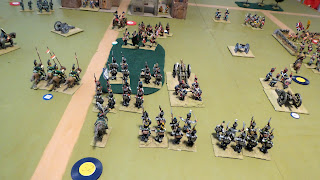Day 1 siege of Soncillo
Battle of Medina
10 French army – rally and regroup at Laredo
11 French army – attack Medina
12 French army – lay siege to Soncillo
1 British army – rally and regroup at Santander
2 British army – defend Medina
3 British army – siege of Soncillo
Guerrilla
20 brigade – attack convoy, fail, routed with 10% casualties
15 brigade – attack convoy, fail, retreat no casualties
18 brigade – attack convoy, fail, retreat no casualties
Both armies start the battle with campaign casualties. This makes them vulnerable to morale tests, so they must avoid unnecessary casualties. This applies particularly to the French, who have to attack.
On the right the British cavalry charge the French as they cross the river. The French cavalry lose the melee and rout back over the bridge, taking the gunners and one infantry brigade wit h them. Without cavalry and artillery it is impossible to continue to attack. By the time they have rallied, and returned to the corps, it is too late to initiate an attack
In the centre the Westphalian corps has no cavalry support. Their cavalry brigade has been used to replace campaign casualties for the French and Italian brigades. The British cavalry take full advantage of this, and pin the Westphalians to the river bank.
On the left the Italian corps press home their attack on the Spanish held farm. The Spanish put up an unexpected determined defence, and almost win a critical melee. However eventually the Spanish break and rout. General Hill makes repeated attempts to rally them, but is unable to do so
The French have taken one objective, but the British hold the other two
The British have won this battle
French have lost 5 infantry casualties (2000 men)
British have lost 1 infantry casualty (400 men)
Spanish have lost 3 infantry and 1 artillery casualties (1300 men)
Comments
This game has highlighted the difference between a campaign game, and a “one off” wargame. In a campaign it is really important to conserve your troops. High casualties in one battle to achieve a victory will often result in comprehensive defeat in the next.
Both armies started this game with moderate campaign casualties. By this I mean that about half of the brigades have 10% casualties. This meant that their combat ability and morale was reduced by a factor of 1 on all combat or morale tests. With the use of just 1D6 to determine the outcome, that can be significant.
This is a particular problem for the attacking player. He usually has to accept some artillery and skirmish casualties as he moves into contact with the defender. When a brigade suffers casualties they have to test their morale. If they rout, all brigades within 4” also have to test. There is a real danger that just one casualties can cause two or three brigades to rout.
This is why I (as attacking player) had to play such a cautious game. I had to protect my advancing infantry from enemy cavalry and artillery fire. In one of my three corps I did not have any cavalry, but the defender did. In another I lost the initial cavalry melee and my routed brigade took my gunners with them!
With these dice driven rules you come to dream a roll of one, and are overjoyed when a six lands. And they do keep you on your toes. Even when you have achieved an initial success you can always be cheated by a particularly low roll during the final melee combat.
We like them, but appreciate that not everyone will










